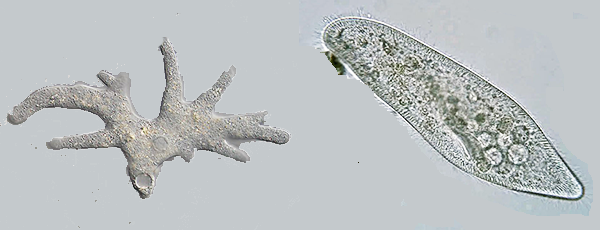Comparing the Ameba to the Paramecium

The amoeba is a single-celled organism with a flexible cell membrane and no fixed shape. It moves and feeds through the formation of pseudopodia, which are temporary projections of its cytoplasm. Amoebas move by extending their pseudopodia and flowing into the direction of their movement.
The paramecium is also single-celled organisms but have a more defined shape, resembling a slipper. They possess cilia, which are hair-like structures used for movement and feeding. Paramecia move using their cilia, which beat in a coordinated manner, allowing them to move more rapidly and in a directed manner compared to amoebas.
Both protists are found in fresh water, like ponds and streams. They are heterotrophs, meaning they must consume food. The amoeba feeds by engulfing food with their pseudopodia. Paramecia sweep food paricles into their oral groove.
Viewing the Ameba
1. Obtain a slide of ameba
2. Do NOT use a coverslip
3. Focus under scanning power and then low power. Do NOT use high power.
Over a 10-15 minute period, draw the ameba four times. Pay special attention to the shape.

1. Describe in your own words how the ameba moves.
2. On one of your drawings above, label the endoplasm, ectoplasm, cell membrane, and pseudopodia.
Viewing the Paramecium
- Obtain a slide of paramecium (no cover slip)
- Focus under scanning and low power.
- Add a few strands of cotton and a cover slip. (The cotton will help slow the paramecium down)
- Refocus using High Power.
Over a 10-15 minute period, draw the paramecium four times.

3. Describe how the paramecium responds to the cotton fiber on the slide.
4. Estimate how many paramecium are on your slide.
5. Draw your paramecium. Label: Nucleus, Oral Groove, Cell Membrane, Cilia, Contractile Vacuole
Analysis
6. Compare the movement of the paramecium to the movement of the ameba.
7. How are the paramecium and the ameba alike?
8. How are the paramecium and the ameba different?

